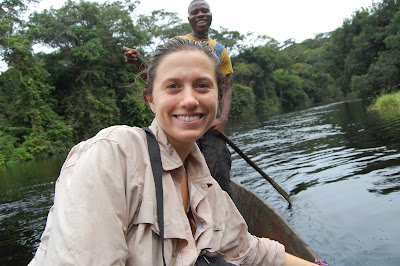A bonobo in the wild. "Understanding the physiological mechanisms underlying the differences in chimpanzee and bonobo behaviors may also give us information about the genes underlying our own behaviors," says Emory anthropologist John Lindo. (Photo by Sarah Kovalaskas)
Chimpanzees and bonobos are sister species that diverged around 1.8 million years ago as the Congo River formed a geographic boundary and they evolved in separate environments. Now, a whole-genome comparison of bonobos and chimpanzees reveals the gene pathways associated with the striking differences between the two species’ diets, sociality and sexual behaviors.
The journal Genes, Brain and Behavior published the comparative analysis, conducted by anthropologists at Emory University.
“Our paper is the first whole-genome positive selection scan between chimpanzees and bonobos,” says John Lindo, Emory assistant professor of anthropology and senior author of the study. “We contrasted the genomes of both species to understand how natural selection has shaped differences between the two closely related primates.”
Lindo is a geneticist specialized in ancient DNA and natural selection. “Chimpanzees and bonobos are fascinating because they are very, very closely linked genetically but they have huge behavioral differences,” he says.
The two species also share around 99 percent of human DNA, making them our closest living relatives in the animal kingdom. “Understanding the physiological mechanisms underlying the differences in chimpanzee and bonobo behaviors — particularly the much stronger propensity of bonobos toward conflict resolution instead of fighting — may also give us information about the genes underlying our own behaviors,” Lindo says.
Sarah Kovalaskas, an Emory graduate student of anthropology, is first author of the paper. Before joining Emory she spent nine months in the field, studying the social development of juvenile bonobos in the Democratic Republic of Congo (DRC). Wild bonobos, an endangered species, are only found in forests south of the Congo River in the DRC.
“Bonobos are well-known for being playful, even as adults,” Kovalaskas says. “It was fun to observe the juveniles twirling around in the trees, chasing one another and trying to pull each other down. When the mothers tried to wean them, they would sometimes throw tantrums and scream and run around. You can’t help but recognize the similarity in behaviors to humans.”
Populations of chimpanzees, also an endangered species, are found in a forested belt north of the Congo River and scattered in a few other areas of west and central Africa.
Bonobos and chimpanzees closely resemble one another physically and they were not recognized as separate species until the 1930s. Their behavioral differences are much more distinct. While bonobos organize into female-led societies, chimpanzees are patriarchal. When bonobos encounter other bonobo groups they generally interact peacefully. Bonobos are also known for using sexual behaviors to defuse tension — including same-sex behaviors among females. Chimpanzees, however, tend to act more aggressively when encountering other chimpanzee groups and may even have violent exchanges that include fatalities.
A leading hypothesis suggests that different feeding ecologies were key to the behavioral divergence between the two species. This theory posits that the abundant ground vegetation in the bonobo territory provided easy access to year-round food without competition from other individuals. Larger groups could feed together instead of foraging in isolation, allowing females to develop strong bonds to counter male domination, and to mate with less aggressive males, leading to a kind of “self-domestication.”
The whole genome comparison showed selection in bonobos for genes related to the production of pancreatic amylase — an enzyme that breaks down starch. Previous research has shown that human populations that began consuming more grains with the rise of agriculture show an increase in copies of a closely related gene that codes for amylase.
“Our results add to the evidence that diet and the available resources had a definite impact on bonobo evolution,” Kovalaskas says. “We can see it in the genome.”
Compared to chimpanzees, bonobos also showed differences in genetic pathways well-known to be related to social behaviors of animals — as well as humans. Bonobos had strong selection for genes in the oxytocin receptor pathway, which plays a role in promoting social bonds; serotonin, involved in modulating aggression; and gonadotropin, known to affect sexual behavior.
“The strong female bonds among bonobos, in part, may be mediated by their same-sex sexual behaviors,” says co-author James Rilling, professor and chair of Emory’s Department of Anthropology. “Our data suggest that something interesting is going on in the bonobo pathways for oxytocin, serotonin and gonadotropin and that future research into the physiological mechanisms underlying behavioral differences between bonobos and chimpanzees may want to target those specific systems.”
Related:
Leading a new era in ancient DNA research




